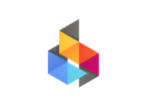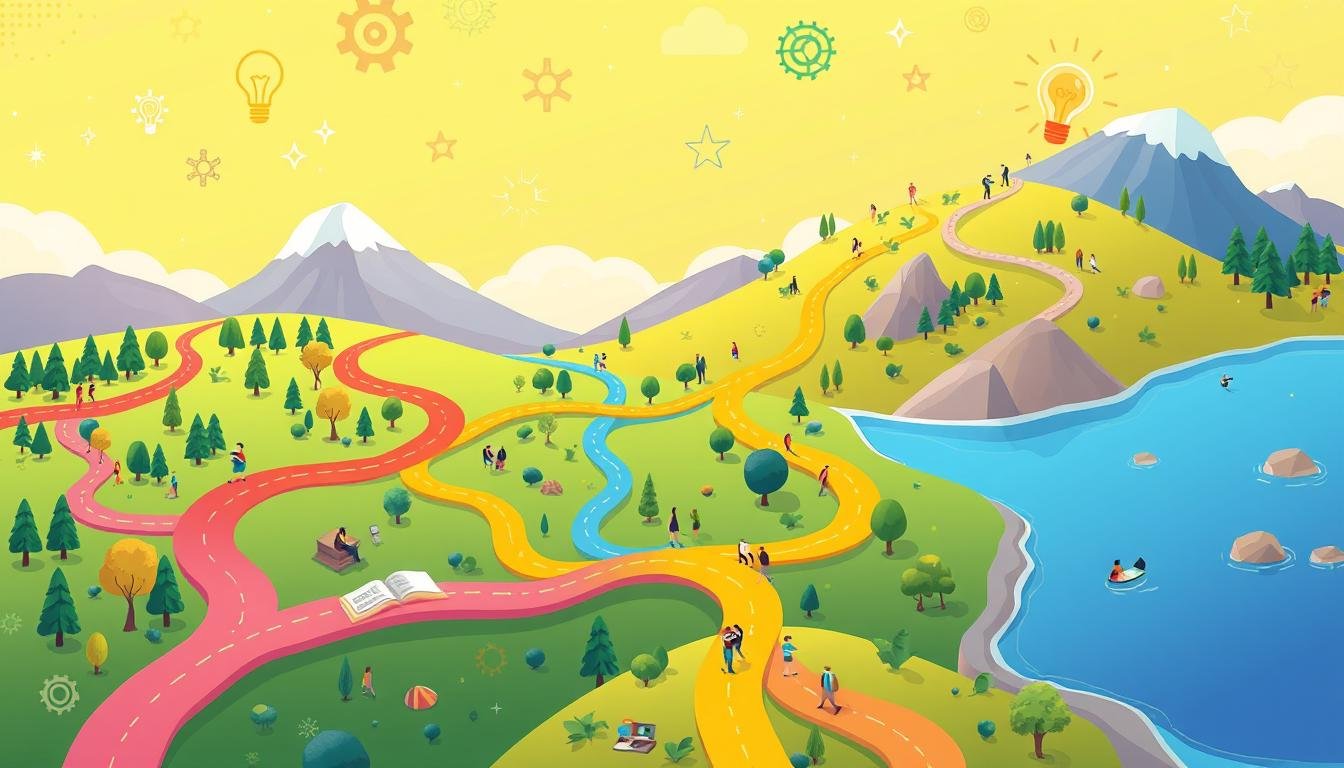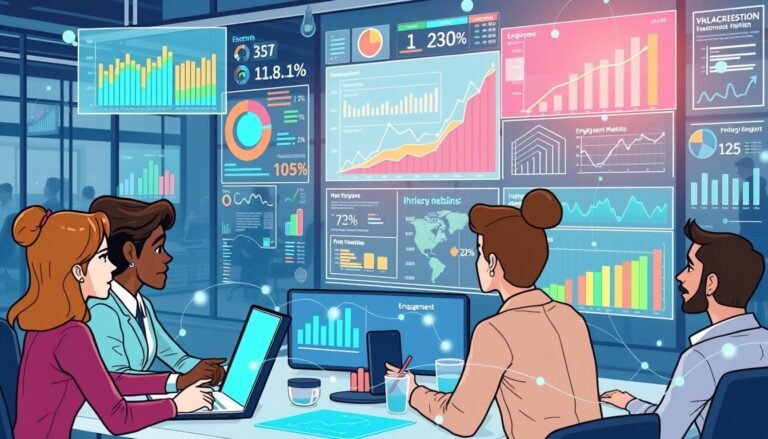Personalized Learning Paths
Education is changing, and personalized learning paths are leading this change. These methods are moving away from the old one-size-fits-all approach. Now, we focus on customized curricula that meet each student’s unique needs.
More schools and workplaces are embracing individualized instruction. A study showed that 93% of employees feel more engaged with well-planned training. This shows how powerful personalization is in both learning and work.
Personalized learning paths offer a tailored way to develop skills. They focus on specific areas, making learning faster and cheaper. This approach not only quickens skill gain but also boosts motivation as learners take charge of their growth.
Key Takeaways
- Personalized learning paths boost employee engagement and retention
- Adaptive learning approaches lead to faster skill acquisition
- Customized curricula are cost-effective and efficient
- Individualized instruction increases learner motivation
- Regular reviews ensure learning paths stay aligned with evolving needs
What Are Personalized Learning Paths?
Personalized Learning Paths change education by making it fit each student’s needs and skills. This new way of learning puts the student at the heart of their education. It changes how classrooms work.
Definition and Overview
At the heart of Personalized Learning Paths is a Tailored Educational Experience. It adjusts the content, pace, and style to fit each learner. This approach lets students control their learning, making it fit their own speed and style.
Importance in Modern Education
Today, Personalized Learning Paths are key for many reasons:
- Students are more engaged in their learning
- They retain information better with tailored content
- It’s flexible for different learning styles and places
- It focuses on filling gaps, not repeating what’s already known
| Traditional Learning | Personalized Learning |
|---|---|
| One-size-fits-all approach | Tailored to individual needs |
| Fixed pace | Self-paced learning |
| Standardized content | Customized learning materials |
| Teacher-centered | Learner-centric approach |
Finland’s success shows the power of Personalized Learning Paths. Since 2009, their new model has boosted student motivation and results without big costs. This method helps students and improves workplace training, with 91% of employees wanting training that fits their role.
Benefits of Personalized Learning Paths
Personalized learning paths bring big benefits to education today. They make learning fit each student’s unique needs. This leads to big improvements in learning.
Enhanced Student Engagement
Differentiated Learning Strategies make learning more engaging. At Belmont-Cragin Elementary School in Chicago, students who struggled got extra help. This approach helps fill learning gaps and keeps students involved in their education.
Improved Academic Performance
Personalized learning paths boost academic results. Students learn at their own speed, focusing on what they need to work on. This model leads to better retention and assessment scores than traditional methods.
Greater Flexibility and Autonomy
Personalized learning offers flexibility and freedom. Students pick their learning paths, which boosts their motivation. This prepares them for the changing job market by teaching them to assess themselves and work with others.
- Students move at their own pace
- Choice in demonstrating knowledge
- Development of tech skills
- Improved self-assessment abilities
By using personalized learning paths, teachers can make learning more engaging, effective, and flexible. It meets each student’s needs and prepares them for success in the future.
Key Components of Personalized Learning Paths
Personalized learning paths are changing education by making lessons fit each student’s needs. This method is popular, with 79% of parents and 73% of teachers not liking the old one-size-fits-all way.
Student Goals and Interests
Understanding what students want to achieve is at the core of personalized learning. By making lessons match what students are interested in, teachers can make learning fun. This approach has led to better math and reading scores in schools.
Tailored Content and Resources
Creating learning materials just for each student is key to personalized learning. This can include special textbooks, online modules, and projects. Learning Management Systems (LMS) help teachers make learning paths for each student.
Continuous Assessment and Feedback
Using Personalized Learning Analytics is vital for checking how students are doing and improving plans. Regular tests help find where students need help, so teachers can act fast. This feedback loop keeps students on track and helps them reach their goals.
| Component | Impact | Implementation Rate |
|---|---|---|
| Student Goals | Increased Engagement | 85% |
| Tailored Content | Improved Comprehension | 78% |
| Continuous Assessment | Enhanced Performance | 92% |
By using these key parts, teachers can make a learning space that changes with each student’s needs. This helps students succeed and learn for their whole lives.
How to Implement Personalized Learning Paths
Creating personalized learning paths needs a careful plan. We’ll look at how teachers can make customized curricula and use adaptive learning.
Step-by-Step Guide for Educators
To make personalized learning paths, follow these steps:
- Define clear learning objectives
- Create a skills matrix to identify gaps
- Map out learning pathways
- Develop tailored learning resources
- Continuously assess and adjust
Studies show personalized learning boosts student interest and grades. Companies using customized curricula see a 50% increase in keeping students.
Technology Tools to Support Implementation
Adaptive learning software is vital for personalized education. Here are some tools that can help:
- Learning Management Systems (LMS)
- Learning Experience Platforms (LXP)
- AI-powered recommendation engines
Involving Students in the Process
Getting students involved is crucial for personalized learning. Encourage them to:
- Set personal goals
- Choose preferred learning methods
- Provide feedback on their progress
By getting students involved, you make learning more engaging and effective. This method fits with the trend of adaptive learning, where content changes based on individual needs.
| Benefit | Percentage |
|---|---|
| Increased student engagement | 30% |
| Improved academic performance | 25% |
| Higher retention rates | 40% |
Challenges in Personalized Learning Paths
Personalized learning paths are exciting for education but face challenges. They need careful planning and thought for individualized instruction and different learning strategies.
Resource Constraints
One big challenge is getting enough resources. A survey of 450 U.S. educators found that getting support from others was a top issue. Teachers struggle to make lessons fit each student’s needs with class sizes of 20-30.
Balancing Personalization and Standardization
Finding a balance between personalized learning and standard goals is hard. Personalized learning lets students learn at their own pace. But, it can cause some to move too fast or slow, making it hard to keep the classroom together.
Teacher Training and Support
Teachers need training to move from leading to student-driven learning. They must learn about different learning needs and new technologies. This change is tough and needs ongoing support.
“Personalized learning is about meeting the educational needs of individual students based on their interests, aspirations, and backgrounds.”
Despite the challenges, personalized learning paths are worth trying. With the right planning and support, schools can create better learning spaces for all students.
Case Studies of Successful Implementation
Schools all over the country have seen big improvements by using personalized learning paths. These stories show how adaptive learning can change education at all levels.
Examples from K-12 Education
In New York City, M.S. 88 saw a 20% jump in math scores after starting personalized assessments. This approach let students learn at their own speed. It boosted their confidence and grades.
The Khan Academy has made a big difference in K-12 education. In a New Mexico district, students using their platform saw a 30% boost in scores. This shows how adaptive learning can really help students do better.
Success Stories in Higher Education
Higher education has also seen big wins with personalized learning. Georgia State University cut its dropout rate by 20% by adding adaptive learning and real-time help. This helped spot and help students who were struggling early on.
Arizona State University saw even better results. Students using adaptive learning modules scored 20% higher on average than those in traditional classes. This approach not only raised grades but also made students more engaged and happy.
| Institution | Improvement | Area of Impact |
|---|---|---|
| M.S. 88, NYC | 20% increase | Math proficiency scores |
| New Mexico District | 30% increase | Overall proficiency scores |
| Georgia State University | 20% reduction | Dropout rate |
| Arizona State University | 20% higher | Average test scores |
These examples show how personalized learning can change education in K-12 and higher schools. By using adaptive learning, schools can make learning more effective and fun for everyone.
The Role of Technology in Personalized Learning
Technology has changed education a lot. It’s changing how we teach and learn. Personalized Learning Analytics and Adaptive Learning Technologies are leading this change.
Learning Management Systems (LMS)
Learning Management Systems are key in today’s education. They help make learning paths for each student. They track how students do, what they like, and their skills.
A study found that 47% of LMS will use AI in the next three years. This will make learning even more personal.
Data Analytics and Reporting Tools
Data analytics tools are vital for personalized learning. They help teachers see how students learn best. Here’s how these tools affect education:
| Impact | Percentage |
|---|---|
| Increase in test scores with AI-driven adaptive learning | 62% |
| K-12 educators using individualized learning | 60% |
| Accuracy of AI chatbots for personalized guidance | 91% |
These tools do more than just analyze data. They make learning more fun. Students using tech for personalized learning are more engaged than those in old ways.
“Personalized learning focuses on empowering students to be producers rather than consumers, developing skill sets that will benefit them in the future.”
As we go forward, technology’s role in personalized learning will grow. It’s an exciting time for education, full of new ways to learn.
Designing Effective Personalized Learning Paths
Creating personalized learning paths needs teamwork and careful planning. It’s about making learning plans that fit each student’s needs and likes.
Collaboration with Educational Stakeholders
Teamwork among teachers, students, and leaders is key for personalized learning. This teamwork makes sure learning plans meet everyone’s needs well.
Research shows 93% of top companies say personalized learning helps workers reach their goals. This shows how important it is to have everyone involved in making learning plans.
Strategies for Curriculum Development
Creating customized curricula involves a few important steps:
- Grouping skills into clusters
- Finding courses and activities that build these skills
- Providing different resources for different learning styles
Personalized learning can increase employee productivity by up to 70%. This shows how well-made learning plans can make a big difference in both school and work.
Using AI-powered Learning Experience Platforms (LXPs) helps make learning plans that fit each person’s needs. This tech makes learning plans more efficient and effective.
“Personalized learning involves designing education that caters to the learner’s unique background, motivations, skills, and goals.”
By using these strategies and working together, teachers can make personalized learning paths. These paths meet each student’s needs and help them succeed in school.
Measuring the Impact of Personalized Learning Paths
It’s important to check how well personalized learning paths work. This means looking at both numbers and stories to see how students are doing and how interested they are.
Key Performance Indicators
Personalized Learning Analytics give us important info on how students are doing. Schools that use these tools see a 20% jump in student interest. The main signs of success include:
- Academic performance improvements
- Student engagement levels
- Attendance rates
- Dropout rates
- Time spent on learning activities
Qualitative vs. Quantitative Assessment
Numbers tell us how students are doing. For instance, students in personalized learning do 8 points better in math and 9 in reading. But, surveys and groups give us a deeper look into what students really think and feel.
Competency-Based Progression is also key. It lets students move forward when they’ve mastered a skill, not just by how long they’ve been in class. Schools using this method see a 35% boost in math skills in just one semester.
| Assessment Type | Benefits | Challenges |
|---|---|---|
| Quantitative | Objective data, easy to compare | May miss nuanced improvements |
| Qualitative | Captures student experiences, identifies specific issues | Subjective, time-consuming to analyze |
By using both numbers and stories, teachers can really understand how personalized learning helps students. This way, they can make smart choices to keep improving.
Future Trends in Personalized Learning Paths
The future of education is changing fast. Adaptive Learning and Personalized Learning Analytics are leading the way. They are changing how students learn and teachers teach.
The Rise of AI and Adaptive Learning Technologies
AI is changing education quickly. A huge 88% of students believe AI is key to learning. Adaptive Learning uses AI to understand students’ strengths and weaknesses.
It also predicts how well students will do. This tech can make learning materials just for each student. It can even use a webcam to check how students feel.
Virtual classrooms are becoming more common. They help students work together online. The future of learning will focus on students working one-on-one with AI.
This might mean less group work. AI will make learning paths just for each student.
Evolving Educational Policies
As tech gets better, education rules are changing too. New rules are being made to protect students. They make sure AI is fair and safe to use.
- Comprehensive guidelines for AI-based learning analytics
- Ethical practices in using AI tools in education
- Promoting equal access to technology to prevent deepening educational inequalities
AI has many good points, but humans are still important. In early education, emotional skills are key. Teachers will keep teaching important skills like talking and solving problems.
Best Practices for Educators
Educators are crucial in making personalized learning successful. They must build strong relationships with students and set clear goals. This approach makes learning more meaningful by focusing on the learner.
Building Relationships with Students
It’s important for teachers to get to know each student well. They should learn about their interests, strengths, and challenges. This helps tailor education to meet each child’s needs.
- Talk with students one-on-one regularly
- Use surveys to learn about student interests
- Observe how students work and interact
Setting Realistic Milestones and Goals
Clear, achievable goals keep students motivated. Teachers should work with students to set targets that challenge them but are reachable. This lets students see their progress and stay interested.
Goals should be:
- Specific and measurable
- Aligned with student interests
- Broken into smaller steps
- Reviewed and updated often
By focusing on these practices, educators can make learning more effective. This approach helps students take charge of their learning and grow at their own pace.
Encouraging Lifelong Learning Through Personalization
Personalized learning paths open doors to lifelong learning. These tailored educational experiences help students grow beyond the classroom. By focusing on individual needs, learners can develop skills that last a lifetime.
Fostering a Growth Mindset
Self-paced learning is key to building a growth mindset. When students learn at their own speed, they gain confidence. This approach shows them that hard work pays off. As a result, they’re more likely to keep learning throughout their lives.
Resources for Ongoing Development
To support lifelong learning, we need the right tools. Online courses, mentorship programs, and self-tests are great options. These resources help learners stay curious and keep growing. With a tailored educational experience, each person can find what works best for them.
Studies show that personalized learning boosts motivation and engagement. It’s not just for kids – adults benefit too. By using adaptive tech and real-world examples, we can create learning plans that fit everyone’s needs. This approach aligns with global goals for quality education and lifelong learning opportunities.
Source Links
- Creating personalized learning paths
- 6 Steps To Implement Learning Pathways in Your Organization
- Personalized Learning: A Teacher’s Guide
- Personalized Learning Paths
- What Is Personalized Learning? Best Practices, Examples
- From One-Size-Fits-All To Tailored Online Education: The Advantages Of Personalized Learning
- 6 benefits of personalized learning
- 5 Key elements of personalized learning – K-20 Blog
- Personalized Learning: A Comprehensive Educator’s Guide
- Adaptive and Personalized Pathways in Moodle – Teaching Resources
- How to Incorporate Personalized Learning Paths Into Training
- Personalized Learning Paths: Navigating the Future of Employee Training
- 5 Personalized Learning Challenges (and How to Overcome Them) – 3P Learning
- Opportunities And Challenges Using AI In Personalized Online Education
- Personalized Learning Pathways: The Future of Student Engagement and Success
- Successful Implementation of Personalized Learning in LMS Environments
- How Personalized Learning Paths in LMS Can Transform Student Progress Tracking and Automation
- Case Study: Distinctive Schools Leads Personalized Learning for English Language Learners in Illinois and Minnesota – Aurora Institute
- Personalized Learning and Technology: Four Things to Keep in Mind
- The Role of Technology in Personalized Learning – EdSurge News
- The Role of AI in Personalized Learning
- How to Build Personalized Learning Paths for Students
- How to Build a Personalized Learning Program
- How to Build a Personalized Learning Plan for Employees
- Assessing the Impact of Personalized Learning Paths on Student Engagement and Outcomes
- Personalized Learning Paths: The Power of Customized Learner Journeys and Tailored Learning • Intellek
- The Future of Personalization in Learning
- Council Post: Personalized Learning And AI: Revolutionizing Education
- How Do Emerging Technologies Help Shape Personalized Learning Experiences?
- Personalized Learning: A Comprehensive Guide for Educators — Modern Classrooms Project
- The Ultimate Personalized Learning Guide
- The Complete Guide to Personalized Learning
- Personalized Learning for Adult Education
- Frontiers | Crafting personalized learning paths with AI for lifelong learning: a systematic literature review
- How Personalized Learning Enhances the Development of Employees








